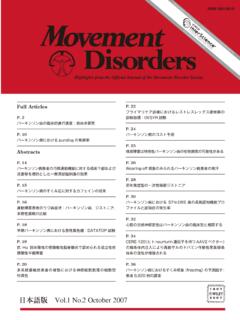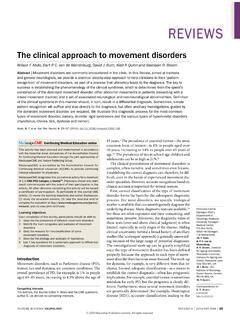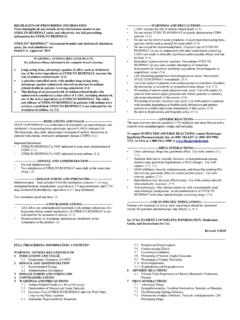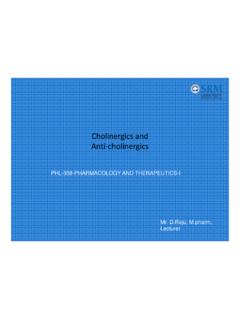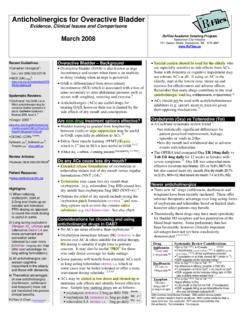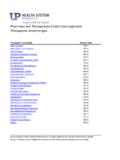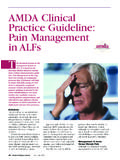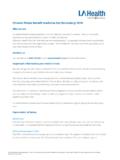Transcription of Drug-induced Movement Disorders
1 Drug-induced Movement Disorders Mishal Abu Al-Melh, MD, FRCPC 19 May 16 Introduction Drug-induced Movement Disorders are varied and can be caused by a number of medications that alter central nervous system neurochemistry (D2 receptor blockade) Include: Parkinsonism Tardive phenomena Chorea Dystonia Tremor Akathisia Myoclonus Tics, and Neuroleptic malignant syndrome The movements can be acute or chronic phenomena. Can be focal, hemi-, or generalized in nature. With the exception of the tardive phenomenon, can usually be treated by elimination of the offending medication. 1. Acute: Akathisia Dystonia 2. Overdosage: Drug-induced Parkinsonism 3. Neuroleptic malignant syndrome Chronic: Tardive Syndromes Dyskinesia Akathisia Dystonia Tremors Tics Myoclonus Acute Dystonia Are sustained muscle contractions, frequently causing twisting and repetitive movements, or abnormal postures.
2 Earliest abnormal involuntary Movement to appear after initiation of dopamine receptor antagonist therapy. Can be associated with oculogyric crisis. The reaction may occur after the first dose. In 50%, occurs within 48 hours. In 90%, it occurs by 5 days after starting the therapy. High incidence rate ( >50%) with highly potent dopamine receptor blockers such as haloperidol. Acute dystonia was significantly higher in males than in females ( vs. , P < ). Younger males ( 30 years) had an extremely high incidence ( ). The incidence is much lower with the atypical antipsychotics. Second generation antipsychotics were associated with a significantly lower risk of acute dystonia (relative risk = ) and acute akathisia (relative risk = ), compared with haloperidol alone. Serotonergic agents have also been reported to induce acute dystonic reactions. Tetrabenazine (TBZ), has been reported to induce acute dystonic reactions.
3 In addition to depleting dopamine, TBZ blocks dopamine receptors. Acute dystonia mostly affect the: Ocular muscles (oculogyric crisis), Face, jaw, tongue, neck, and trunk, and Less often the limbs. A typical acute dystonic reaction may consist of : head tilt backward or sideways with tongue protrusion and forced opening of the mouth, often with arching of trunk and ocular deviation upward or laterally Hypothesis: After neuroleptic dose: 1- Surge of dopamine release 2- Denervation supersensitivity of postsynaptic dopamine receptors 3- Result in markedly increased striatal dopaminergic activity at about 20 40 hours Symptoms can be relieved within minutes after parenteral anticholinergics or antihistaminics. D/c offending drug . Diphenhydramine 50 mg, benztropine mesylate or biperiden 1 2 mg is given intravenously. Intravenous diazepam If untreated, the majority of cases still resolve spontaneously in 12 48 hours.
4 Dopamine receptor antagonists with high anticholinergic activities have low incidence rates of acute dystonic reactions. Prophylactic use of anticholinergics especially in the young and on high potency drugs. Acute Akathisia A hyperkinetic (sensorimotor) Movement disorder characterized by restlessness and the irresistible urge to move. May be an acute, subacute, or tardive phenomenon. Might reflect an alteration of the dopaminergic mesolimbic system. Occurs with medications that alter central nervous system dopamine levels ( 20%-30%) Including: typical > atypical neuroleptics, antiemetic agents, reserpine, and tetrabenazine. The motor aspect of akathisia (akathitic movements): Excessive movements that are complex, semipurposeful, stereotypic, and repetitive, suppressible and decrease with distraction. Akathisia is also seen in patients with Parkinson disease, cocaine abuse, and SSRI use.
5 (Daras et al., 1994), ands (Poyurovsky et al., 1995) Acute akathisia is self-limited, disappearing on discontinuation of neuroleptics. First line therapies include: Propranolol : Below 80 mg/day Mirtazipine : A literature search revealed mirtazapine to be effective and superior to propranolol ( vs. ) (Hieber et al., 2008) Trazadone Clonidine Mianserin : 5 HT2 antagonist Nicotine patch Amantadine Tetrabenazine/reserpine Gabapentin Zolpidem : GABA-mimetic drug & selective agonist of the BZD receptor. Fluvoxamine, a sigma-1 agonist Potential future class of medications that may be effective in treating akathisia is the adenosine A2a antagonist group. DBS +/- One study compared the efficacy of B6, mianserin and placebo in the treatment of acute akathisia Sixty schizophrenia and schizoaffective in-patients with akathisia were randomized to receive vitamin B6 1200 mg/d, mianserin 15 mg/d, or placebo for 5 days, in a double-blind design Compared with the placebo group, the vitamin B6-treated and mianserin-treated patients showed a significant improvement in the subjective symptoms (P < ) Drug-induced Parkinsonism Clinically indistinguishable from idiopathic Parkinson s disease.
6 May occur as a symmetric or asymmetric phenomenon. Tremor, rigidity, bradykinesia, and less commonly postural instability are common features. Due to medications that affect presynaptic, synaptic, or postsynaptic dopamine levels. Women are affected almost twice as frequently as men. Occurs increasingly with advanced age in parallel with the incidence of idiopathic PD. All DRBAs can induce parkinsonism, except clozapine (there are only rare reports with clozapine) Factor and Friedman, 1997) It can be either a subacute or chronic condition. In patients at risk, 50% to 70% will develop symptoms within 1 month of starting therapy and 90% within 3 months (Ayd, 1961). The most effective treatment for Drug-induced parkinsonism is elimination of the offending medication. If symptoms persist, the patient most likely has subclinical parkinsonism that was unmasked.
7 Neuroimaging with [18F]fluoro- dopa positron emission tomography : Patients with pure drug - induced parkinsonism will have normalization of their radioactive dopa uptake in the basal ganglia after elimination of precipitating drugs. While patients with unmasking of an underlying parkinsonism will have persistent diminished uptake after elimination of the precipitating medication (Burn and Brook, 1993) Parkinsonism from neuroleptics is typically reversible when the medication is reduced or discontinued. Sometimes, the reversal can take many months; an interval of up to 18 months has been noted in the literature (Fleming et al., 1970). SSRIs can sometimes worsen parkinsonism in patients with PD (Meco et al., 1994). Occasionally can induce parkinsonism in patients who never had symptoms of PD (Coulter and Pillans, 1995; DiRocco et al., 1998) In an intensive monitoring program in New Zealand of the SSRI drug fluoxetine over a 4-year period, there were 15 reports of parkinsonism in 5555 patients who were exposed to the drug (Coulter and Pillans, 1995) The explanation for inducing or enhancing parkinsonism is that: Increased serotonergic activity in the substantia nigra will inhibit dopamine-containing neurons, Thus causing functional dopamine deficiency in the nigrostriatal pathway (Baldessarini and Marsh, 1992 Treatment: Stop the offending drug Usually initiated with anticholinergics or amantadine.)
8 Levodopa & dopamine agonist not effective except in cases who were on dopamine depletors ( reserpine). Neuroleptic Malignant Syndrome NMS is an idiosyncratic reaction that can sometimes be life-threatening. Clinical triad consists of: (1) Hyperthermia, usually with other autonomic dysfunctions such as tachycardia, diaphoresis, and labile blood pressure (2) Extrapyramidal signs, usually increased muscle tone of rigidity or dystonia, often with accompanying elevation of muscle enzymes; and (3) Alteration of mental status, such as agitation, inattention, and confusion. DSM-IV: Increased temperature and muscle rigidity accompanied by two or more of the following: 1- Diaphoresis 2- Tremor 3- Dysphagia 4- Altered mental status 5- Tachycardia Incontinence Dysregulation of blood pressure Leukocytosis, and elevated creatine kinase. Fever is not an essential symptom and it can be delayed.
9 The syndrome begins abruptly while the patient is on therapeutic, not toxic, dosages of medication. All the symptoms are fully manifest within 24 hours and reach a maximum within 72 hours. ( 3-9 days of tx) NMS can develop soon after the first dose or at any time after prolonged treatment. Recovery usually occurs within 1 to several weeks, but can be fatal in 20 30% of cases. The incidence of NMS is between and Mortality rates have been reported as low as 4% and as high as 20% (Bertorini, 1997). Pathophysiologic basis: dopaminergic dysregulation and blockade of dopamine in the basal ganglia and hypothalamus. All agents that block D2 receptors can induce NMS, including : Risperidone Amisulpride Olanzapine and Phenothiazines with antihistaminic activity, such as alimemazine A case of NMS associated with bupropion has been reported (Kasantikul and Kanchanatawan, 2006) Tetrabenazine has been reported to cause NMS; this seems likely to be due to its D2-blocking activity (Reches et al.)
10 , 1983) Reserpine has not been reported to cause NMS. Abrupt withdrawal of levodopa & dopamine agonists. Risk factors for NMS: 1- Psychomotor excitement 2- Refusal of food 3- Weight loss 4- Oral administration of haloperidol at 15 mg/day or above. 5- Young males appear to be more predisposed. Reports of an NMS-like syndrome following the sudden withdrawal of: Amantadine Baclofen Combination of a long-acting neuroleptic and an anticholinergic agent. The idiosyncratic nature and rarity of the syndrome remain unexplained. TaqI A polymorphism of the dopamine D2 receptor gene appears to occur more commonly in patients who developed NMS. Kishida et al. (2004) found that patients with NMS had a higher association with a polymorphism in the D2 receptor gene. Treatment of NMS consists of discontinuing the antipsychotic drugs and providing supportive measures.


